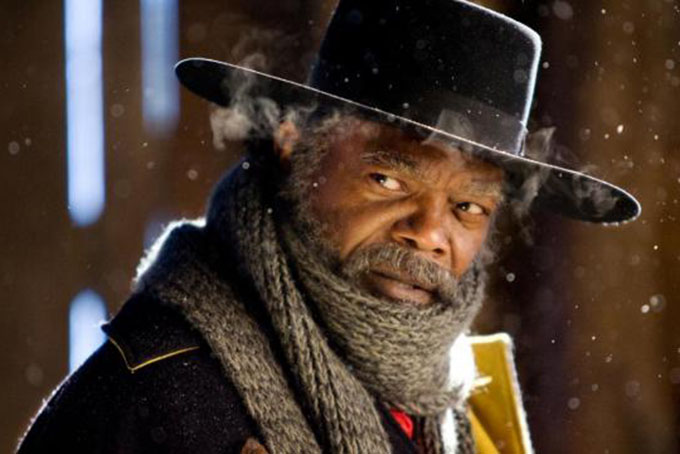
“The Hateful Eight” is not for the faint at heart. What Quentin Tarantino movie is? But while cinema’s favorite cinephile is up to some of his old tricks in his eighth feature, this over three hour long drawing room thriller also feels like a step forward for the wayward enfant terrible _ a step toward maturity.
That’s not to say he’s mellowed. You need only spend a minute with 87-year-old Ennio Morricone’s throbbing, malicious score to know that to be true. Instead, Tarantino shows relaxed power with “The Hateful Eight.” It’s easy authority that’s less manic than the cinematic language we’ve grown to expect from him. And it still packs a punch to the gut, or, in the spirit of Jennifer Jason Leigh’s murderous prisoner, some repeated blows to the head.
This tale of eight unsavory creatures stranded in a one-room haberdashery in the middle of a nasty Wyoming blizzard is in no hurry to get where it’s going, and the audience is better off for it.
It’s a whodunit when no one has done anything yet _ more like a who’s gonna do it, and what exactly are they gonna do. Everyone is bad, everyone has a secret, and everyone is the hero of their own story.
There’s Samuel L. Jackson as the hyper literate bounty hunter Major Marquis Warren who carries a personal letter from Abraham Lincoln in his coat pocket; Kurt Russell as the violently affable John Ruth who’s transporting a prisoner to town to be hanged for a $10,000 bounty; Leigh as said prisoner; Daisy Domergue, whose bloody Cheshire grin says more than any monologue ever could. Walton Goggins plays Chris Mannix, the soon-to-be sheriff who may be a master manipulator or just plain dumb; Demian Bechir is Bob, who runs the Haberdashery; Michael Madsen as Joe Gage, the menacingly quiet one in the corner; Tim Roth as Oswaldo Mobray, a British hangman who seems like a Christoph Waltz stand-in before he finds his groove; and Bruce Dern as an ornery Confederate general, wondering what’s become of his life now that the war is done.
It seems like a lot, but it’s really not. That’s the brilliance of Tarantino. Each of his characters is so distinctive, so rich, that they pop off the screen as soon as you meet them. It is refreshing when so many ensemble movies seem to confuse character development with something more akin to “here’s a famous person who you’ll remember.” Vivid costuming work from Courtney Hoffman only adds to their uniqueness.
Tarantino also keeps you on the edge of your seat wondering who to trust, or, at the very least, side with. It changes every 15 minutes as the mystery unravels, and then explodes.
The conversations are as nimble as ever, whether they’re talking coffee, war, or the benefits of transporting prisoners dead or alive.
A big deal has been made about the presentation of “The Hateful Eight.” Tarantino and his cinematographer Robert Richardson shot the film in Ultra Panavision 70, a basically dead format that was used on only a few films, such as “Mutiny on the Bounty.” There’s even an overture and an intermission at the roadshow presentations.
It’s hard to see how that’s not mostly posturing as most of the film is set in one room, but it does add a theatrical wonder to it all even if the “glorious 70mm” depends a great deal on the individual projectionist. In the screening I attended, the film was so blurry that they switched to digital at intermission. For what it’s worth, the digital looked great.
Besides, we need Tarantino to go all out in whatever ways he deems necessary even if we don’t always understand it. If he didn’t he wouldn’t be Tarantino and we’d be missing out.
“The Hateful Eight,” a Weinstein Company release, is rated R by the Motion Picture Association of America for “strong bloody violence, a scene of violent sexual content, language and some graphic nudity.” Wide release run time: 167 minutes. 70mm Roadshow Run Time: 187 minutes with a 12 minute intermission. Three and a half stars out of four.
___
MPAA Definition of R: Restricted. Under 17 requires accompanying parent or adult guardian.
___
Follow AP Film Writer Lindsey Bahr on Twitter: www.twitter.com/ldbahr